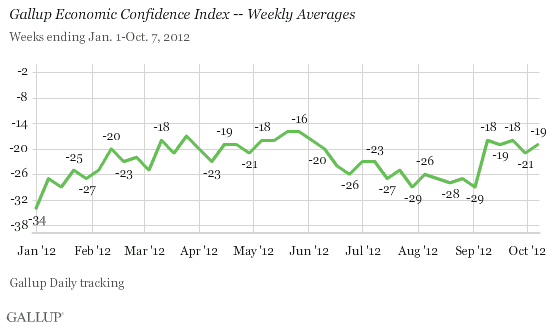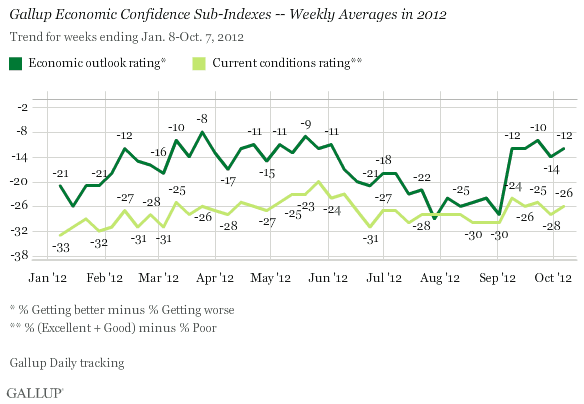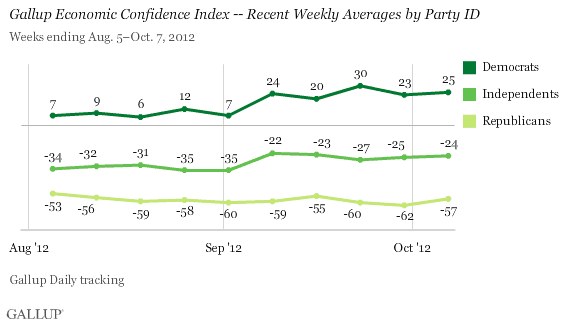WASHINGTON, D.C. -- Gallup's U.S. Economic Confidence Index increased slightly to -19 for the week ending Oct. 7, up from -21 the week prior but little changed from the previous four weeks, during which it has hovered within a narrow range of -18 to -21.

Although the U.S. Bureau of Labor Statistics reported a decline in the unemployment rate Friday, economic confidence did not improve in Gallup Daily tracking interviewing conducted Friday through Sunday and, at -21, was actually lower than readings earlier in the week.
The slight increase in economic confidence last week was the result of a modest improvement in both components of the index: one that assesses current economic conditions and the other that assesses the nation's economic outlook. Fifteen percent of Americans say the economy is excellent or good, while 41% consider it poor, resulting in a -26 current conditions rating, up slightly from the previous week.
The -12 economic outlook rating also reflects a slight increase over the previous week, with 42% of Americans now saying the economy is getting better and 54% saying it is getting worse.

Democrats and Republicans Remain Sharply Divided
Democrats and Republicans continue to be sharply divided in their perceptions of the economy, although both improved slightly over the previous week, to +25 and -57, respectively. Independents continue to have net negative views of the economy, at -24.
The polarization by party comes chiefly from opinions about the future of the economy. The majority of Republicans (81%) and independents (56%) say the economy is getting worse, while 74% of Democrats say it is getting better.

A minority of Americans say the economy is excellent or good, a measure on which all parties find common ground. Twenty-four percent of Democrats, 9% of Republicans, and 14% of independents report that the economy is excellent or good.
Bottom Line
The lack of improvement in economic confidence after the BLS jobs report may come as a bit of a surprise. However, the report was met with skepticism by many, as the consensus among economists was that the adjusted unemployment rate would be flat. This was in line with Gallup's employment data, which found unemployment to be unchanged on a seasonally adjusted basis in September. Despite the government's report showing modest job growth, Americans may not be feeling daily improvements in their economic situation.
Agreement across party lines as well as improved perceptions of the current state of the economy will be crucial to moving Americans' economic confidence from net negative to net positive. Although economic confidence has maintained its post-convention bump over the last five weeks, it is unclear at this point whether this will continue throughout the election season. Because of the sharp political divide, presidential election polling numbers may play a role in this: voters may report increased confidence if they suspect their favored candidate is ahead in the polls. Given the influence of Americans' political views on their outlook for the economy, it is possible that changes in the presidential race -- reflected in polls -- could influence voters' perceptions of the future of the economy.
Gallup.com reports results from these indexes in daily, weekly, and monthly averages and in Gallup.com stories. Complete trend data are always available to view and export in the following charts:
Daily: Employment, Economic Confidence, Job Creation, Consumer Spending
Weekly: Employment, Economic Confidence, Job Creation, Consumer Spending
Read more about Gallup's economic measures.
View our economic release schedule.
Survey Methods
Results are based on telephone interviews conducted as part of Gallup Daily tracking from Oct. 1-7, 2012, with a random sample of 3,325 adults, aged 18 and older, living in all 50 U.S. states and the District of Columbia, selected using random-digit-dial sampling.
For results based on the total sample of national adults, one can say with 95% confidence that the maximum margin of sampling error is ±2 percentage points.
Interviews are conducted with respondents on landline telephones and cellular phones, with interviews conducted in Spanish for respondents who are primarily Spanish-speaking. Each sample includes a minimum quota of 400 cell phone respondents and 600 landline respondents per 1,000 national adults, with additional minimum quotas among landline respondents by region. Landline telephone numbers are chosen at random among listed telephone numbers. Cell phone numbers are selected using random-digit-dial methods. Landline respondents are chosen at random within each household on the basis of which member had the most recent birthday.
Samples are weighted by gender, age, race, Hispanic ethnicity, education, region, adults in the household, and phone status (cell phone only/landline only/both, cell phone mostly, and having an unlisted landline number). Demographic weighting targets are based on the March 2011 Current Population Survey figures for the aged 18 and older non-institutionalized population living in U.S. telephone households. All reported margins of sampling error include the computed design effects for weighting and sample design.
In addition to sampling error, question wording and practical difficulties in conducting surveys can introduce error or bias into the findings of public opinion polls.
For more details on Gallup's polling methodology, visit www.gallup.com.
